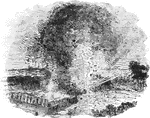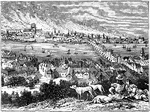Clipart tagged: ‘demolish’
!["The viciously inclined considered that the parliamentary order to destroy all 'monuments of idolatry' gave them liberty and license for every kind of sacrilege; so that it became a common pastime to break the painted windows and deface any statuary which adorned and beautified [England's] churches. The old market crosses which had been a notable feature of English tows, reminding the passers by of the great act of Redemption, were all ruthlessly destroyed."](https://etc.usf.edu/clipart/55500/55569/55569_cheapside_mth.gif)
Destruction of Cheapside Cross
"The viciously inclined considered that the parliamentary order to destroy all 'monuments of idolatry'…

Blowing Up Fort Hill Bastion
As June wore on, Grant pressed the siege with vigor. Johnston tried to help Pemberton, but could not.…

Twenty One Disk Harrow
In agriculture, a set of harrows is a n implement for cultivating the surface of the soil.

Great Fire of London
The Great Fire of London, a major conflagration that swept through the central parts of London from…

Old St. Paul's Cathedral
Old St. Paul's is a name used to refer to the Gothic cathedral in the City of London built between 1087…